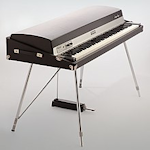
The Fender Rhodes piano is a musical instrument that was first introduced in the 1960s by the Fender Musical Instrument Corporation, named after its inventor, Harold Rhodes. It is an electric piano that uses hammers to strike metal tines, which are then amplified and played through a speaker system.
In 1959, Fender began by marketing the Piano Bass, a cut-down version of Rhodes' invention consisting of the 32 bottom keys. The full-size instrument was not produced until after Fender's sale to CBS in 1965.
The Fender Rhodes was a popular instrument in many genres of music, including jazz, rock, and pop. Its warm, mellow sound and expressive capabilities made it a favorite among keyboard players. It has been played by a wide range of artists, including Herbie Hancock, Stevie Wonder, and Chick Corea.
There were several models of the Fender Rhodes electric piano produced over the years, each with its own unique features and sound. Some of the most well-known models include the Rhodes Suitcase Piano, the Rhodes Stage Piano, and the Rhodes Mark I, Mark II, and Mark V. Each model has its own unique features and sound characteristics. The Mark I, for example, has a brighter, more percussive sound, while the Mark II has a more mellow and rounded tone.
Despite its popularity, production of the Fender Rhodes electric piano ceased in the early 1980s due to financial troubles at Fender. However, the instrument has continued to be used by musicians and can be found in many recordings to this day. In recent years, there has been a resurgence of interest in the Fender Rhodes, and some companies have even started producing new versions of the instrument.
The Fender Rhodes electric piano has become a classic instrument, and its unique sound has been widely imitated by digital keyboards and software synthesizers. However, many musicians still prefer the original instrument for its authentic sound and feel.
Trivia: While considered an electronic instrument, the sounds are produced mechanically by the tines and tone bars. As such, the instrument can still be played, albeit very softly, without being powered, similar to an electric guitar.
